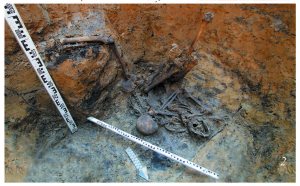Voronezh State Pedagogical University, Voronezh, Russia
E-mail: razuvaevyd@mail.ru
Keywords: the Upper Don region, the Scythian period, fortified settlement, well, collective burial.
The paper publishes the results of studying a well related to the Upper Don fortified settlement of the second half of the 6th – early 5th century BC at the village of Verkhneye Kazachye in Lipetsk Region. The structure was a rectangular pit measuring approx. 1.1 × 1.3 m and more than 6 m deep with walls sheathed with wooden boards, which were traced in the lower part of it. After the fire that destroyed the settlement of the beginning of the Scythian period, the abandoned well deteriorated for some time. A rounded pit formed in its place about 4 m deep was used for collective burial. The bodies of three men were put into it and covered with earth. One of the individuals was 35–45 years old, the others were over 50. At 1.2 m above it, a partially preserved skeleton and individual bones of another man aged over 50 were placed. Most likely, individual parts of cow carcasses and fragments of handmade ceramic vessels accompanied human remains. Two bone harpoon points were found above the burial. Clay and carbonaceous layers associated with ritual activities covered the well pit filled to the top. Based on the pottery materials, the burial in the well dates back to the 4th – 3rd centuries BC. In general, it is similar to the burial-sacrificial complexes of the same time known at another Upper Don fortified settlement in Semiluki. Those also included burials of complete and scattered skeletons, traces of post-funeral rituals represented by bonfires, animal bones and fragments of pottery.
DOI: 10.31857/S086960630013723-4








